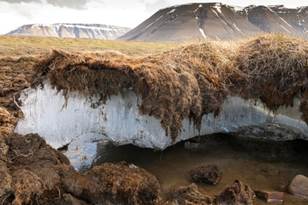Description

Disclaimer: copyright infringement not intended.
Context
- Thawing of the permanent frozen land (permafrost) in the Arctic can have consequences exacerbating global warming and be directly harmful to human health, a new study showed.
.jpg)
What is Permafrost?
- Permafrost is any ground that remains completely frozen—32°F (0°C) or colder—for at least two years straight.
- These permanently frozen grounds are most common in regions with high mountains and in Earth’s higher latitudes—near the North and South Poles.
- Permafrost covers large regions of the Earth. Almost a quarter of the land area in the Northern Hemisphere has permafrost underneath.
- Although the ground is frozen, permafrost regions are not always covered in snow.
- Permafrost is made of a combination of soil, rocks and sand that are held together by ice. The soil and ice in permafrost stay frozen all year long.
- Near the surface, permafrost soils also contain large quantities of organic carbon—a material leftover from dead plants that couldn’t decompose, or rot away, due to the cold. Lower permafrost layers contain soils made mostly of minerals.
- A layer of soil on top of permafrost does not stay frozen all year. This layer, called the active layer, thaws during the warm summer months and freezes again in the fall.
- In colder regions, the ground rarely thaws—even in the summer.
- There, the active layer is very thin—only 4 to 6 inches (10 to 15 centimeters).
- In warmer permafrost regions, the active layer can be several meters thick.

Thawing of Permafrost
- When surface air temperatures rise, below-ground temperatures do, too, thawing permafrost along the way.
- While global warming is upping temperatures around the world, the Arctic is warming twice as fast as anywhere else—and faster than it has in the past 3 million years.
- Scientists estimate there is now 10 percent less frozen ground in the northern hemisphere than there was in the early 1900s.
- One recent study suggests that with every additional 1.8°F (1°C) of warming, an additional 1.5 million square miles of permafrost could eventually disappear.
- Even if we meet the climate targets laid out during the 2015 Paris climate talks, the world may still lose more than 2.5 million square miles of frozen turf.
Impacts of Permafrost Thawing
The loss of greenhouse gas stores
- When plants and animals die, the microbes that decompose their bodies release carbon dioxide, methane, and other global warming gases into the air.
- A deep freeze effectively hits the pause button on that process and preserves organisms and the gases they would otherwise emit underground.
- When frozen soil thaws, the microbial decomposition of those organic materials—and the release of greenhouse gases—starts anew.
Crumbling infrastructure
- About 35 million people live in a permafrost zone, in towns and cities built on top of what was once considered permanently frozen ground.
- But as that solid ground softens, the infrastructure these communities rely on grows increasingly unstable.
- In the northwest of Canada, now we have a short section of the road where it has been necessary to chill the ground to make the foundation of the road colder than it is, in order to preserve the permafrost.
Altered landscapes
- Thawing permafrost alters natural ecosystems in many ways.
- It can create thermokarsts, often characterized by “drunken forests”.
- It can make soil—once frozen solid—more vulnerable to landslides and erosion, particularly along coasts.
- It can alter the flow of rivers and streams, degrade water quality and impact aquatic wildlife.
- Wetlands also deteriorate along with permafrost, as the water sinks further underground without a frozen buffer to keep it in place.
- This can create drier terrain more susceptible to wildfires, which expose even more permafrost to warming.
- The loss of permafrost will contribute to sea level rise.
Risk of diseases
- Just as permafrost locks in carbon and other greenhouse gases, it can also trap—and preserve—ancient microbes. Some bacteria and viruses lie dormant for thousands of years in permafrost’s cold, dark confines before waking up when the ground warms.
- A 2016 anthrax outbreak in Siberia, linked to a decades-old reindeer carcass infected with the bacteria and exposed by thawed permafrost, demonstrated the potential threat.
Steps to stop permafrost from Thawing
- Reducing carbon footprint
- Investing in energy-efficient products
- To follow a 1.5°C-consistent pathway, the world will need to decrease fossil fuel production by roughly 6 per cent per year between 2020 and 2030.
- Global CO2 emissions need to be reduced by 45% over the next decade, and that they fall to zero after 2050.
- By supporting climate-friendly businesses, legislation, and policies, we can help preserve the world’s permafrost and avert a vicious cycle of an ever-warming planet.
https://www.downtoearth.org.in/news/climate-change/thawing-permafrost-can-pose-direct-threat-to-human-health-report-79869

















